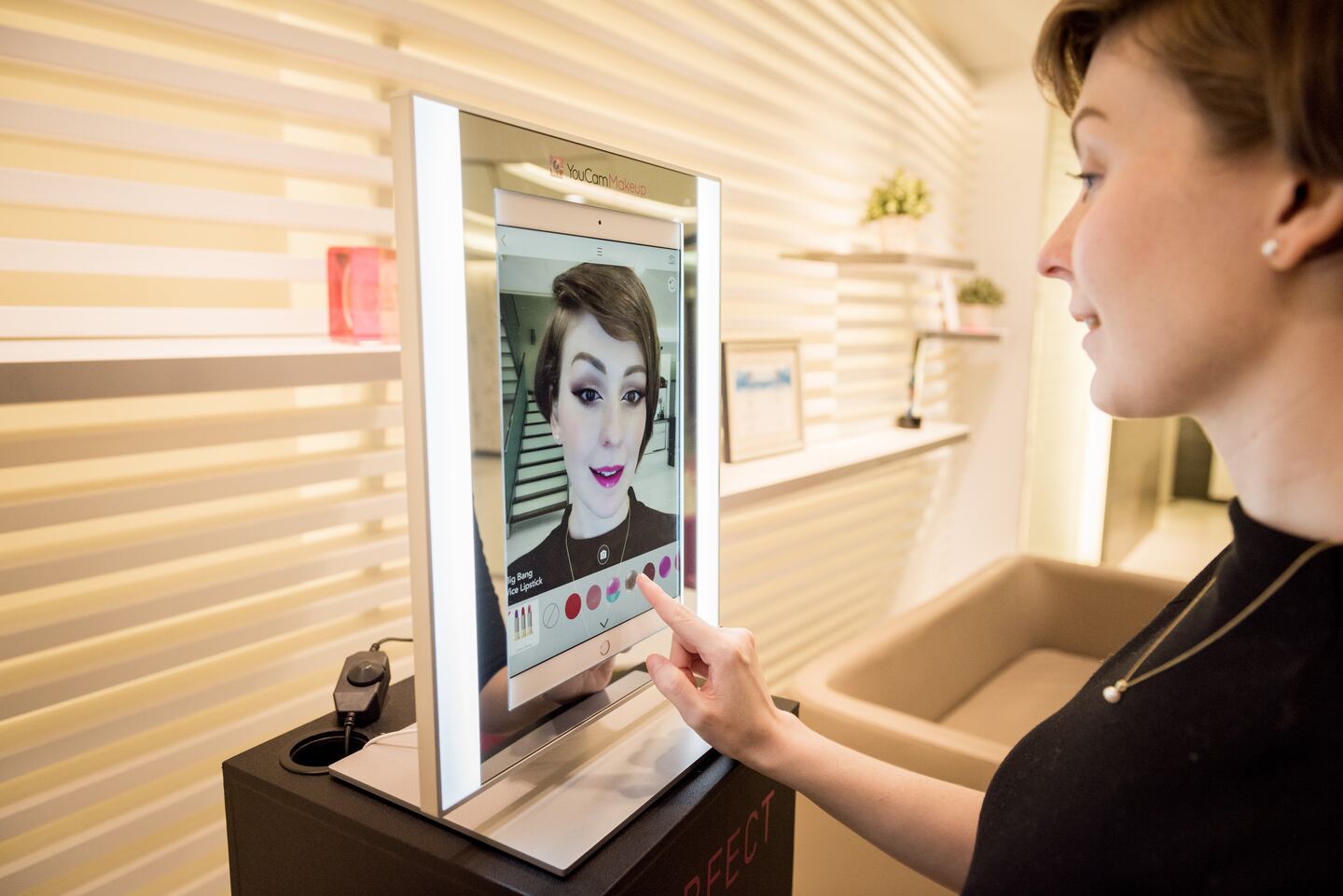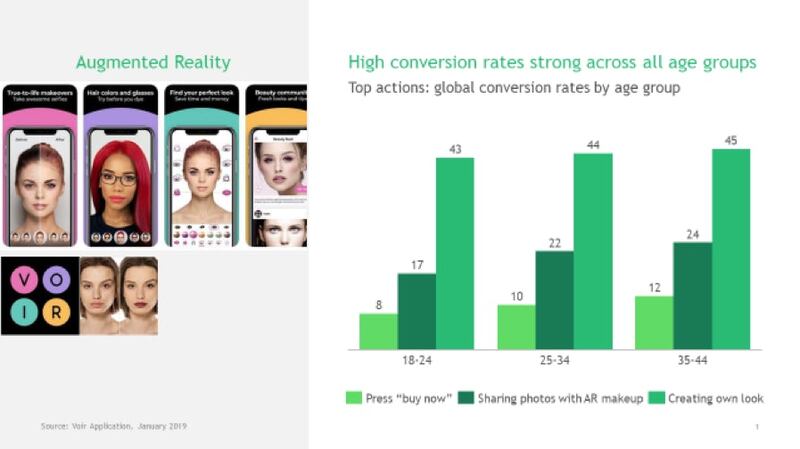
The Business of Fashion
Agenda-setting intelligence, analysis and advice for the global fashion community.

Agenda-setting intelligence, analysis and advice for the global fashion community.

BOSTON, United States — Picture this: It's 2020, and Andrea, a 22-year-old student about to graduate from a top-tier school on the West Coast, has a summer internship FaceTime interview scheduled with a prestigious private equity fund for which she's been preparing for weeks. Ahead of the call, she styles her hair, washes her face, and puts on a navy silk blouse and small gold hoop earrings.
But rather than applying equally business-appropriate makeup, she whips out her phone and begins to choose from a virtual palette of base, concealer, blush, lip gloss and more. Once she dials into her video interview, her virtual makeup will appear within seconds.
As an early member of the Founder generation (those born since 1997), Andrea has never known life without a smartphone and is incredibly well versed in the use of face filters on Instagram Stories, Snapchat and TikTok, her favorite social media platform. Like many Founders, she buys most of her makeup and other personal care products online, and so was an early adopter of augmented reality (AR) makeup apps to experiment with and choose the products she wanted to buy. Once virtual makeup tools for phones became available, using one for her summer internship interviews was subsequently a natural progression. If she gets called in for a final interview in person she will of course wear “real” makeup, but it too will be makeup that she bought after virtually trying it on via an app.
Software is eating the world, and beauty is no exception.
As Marc Andreesen famously theorised, software is eating the world, and beauty is no exception. In present-day 2019, the list of shopping tools in the beauty and skincare world, which includes everything from mobile payments to shoppable social media content, grows longer by the day.
ADVERTISEMENT
That list includes AR for beauty in the form of makeup try-on apps both in stores and on mobile phones and, sooner or later, virtual makeup for use in video chat applications like FaceTime and Skype. Conferencing software Zoom already offers a "Touch Up My Appearance" feature that softens the focus to smooth out wrinkles and minimise blemishes.
Currently, however, just 23 percent of consumers are even aware that there are makeup try-on apps available outside of stores, according to a survey of 1,216 US women who buy prestige beauty products — not mass market, but not necessarily luxury either— conducted by The Boston Consulting Group with beauty trade organisation Cosmetic Executive Women. But, once they learn about those AR beauty apps, more than half (52 percent) do use them. When it comes to women of the Founder generation, this number jumps to over 70 percent.
In the meantime, as more and more consumers shop using their smart phones, conversion rates are declining, at times to as low as a third for desktop and tablet conversion in some apparel and beauty categories. The use of AR — not just in beauty, but in categories such as sneakers, jewellery and a host of others — could help reverse that trend.

Exhibit 1
As with many new technologies, however, consumers often don’t know a good thing until they are actually using it. To gauge the potential usage of AR apps in beauty, we were fortunate enough to gain access to data from a new AR beauty application, called Voir, which to date has some 2.5 million downloads and 15,000 paying subscribers. Its data shows that between 8 and 12 percent of shoppers ages 18-44 who test beauty products in a mobile AR app hit the "buy" button (see Exhibit 1) — compared to average conversion rates of between 1 and 3 percent for many websites. Even assuming some drop off from the hitting of “buy” to an actual sale and this could be transformational for digital commerce.
Combine this with the opportunity for additional growth in beauty — among the female prestige shoppers we surveyed, 40 percent said they planned to spend more over the next 12 months, and of that 40 percent, 8 to 9 percent were planning to spend significantly more — and it becomes clear that to capture share of this planned increase in spending, beauty brands and retailers need to make AR a core feature of the experience they offer consumers now. But first they have to understand where their target audience shops, and how that differs by generation — in particular for Founders and Millennials, whose awareness and usage of shopping technology like AR is the highest, and from whom most of the growth will come from.

Exhibit 2
When it comes to beauty, nearly half of the new spend will take place online, most of it on Amazon via Prime. Among Founder and Millennial (born between 1981 and 1996) prestige beauty shoppers, Amazon and multibrand specialty retailers like Sephora and Ulta account for more than 50 percent of personal care product purchases (see Exhibit 2). AR offers a way for all brands and retailers to compete with Amazon, not just those focused on beauty. This is because it can not only drive conversion by offering consumers an immersive experience, but also by making the immersive experience wholly personalised.
ADVERTISEMENT
What is going to drive the acceleration of AR? A couple of notable brands or one big retailer that embraces it through partnership with, or ownership of, a cutting-edge AR provider.
In beauty, there are already some notable brands investing in this technology. For example, in November 2017, Japanese multinational beauty and personal care maker Shiseido bought Giaran, an award-winning, data-driven start-up with leading AI platforms for mobile, tablets and smart mirrors to offer consumers a way to apply and remove makeup virtually so they can see how they look before making purchases. In March 2018, L'Oréal acquired AR platform Modiface, the first time the global cosmetics brand had ever bought a tech firm.
Meanwhile, new AR applications like Voir are offering a myriad of products and features to an audience ready to click and buy directly. It's a potent combination, producing enviable levels of retention and early conversion rates well above those typically experienced today.
This new (augmented) reality, led by Founders and Millennials, is already changing the way beauty products are sold — and helping brands and retailers sell more of them. But AR's uplift won't be limited to beauty alone. Any category where consumers seek to try on product will benefit from it. Those categories that don't already make use of AR, or are taking steps to, will quickly find themselves unable to compete.
Sarah Willersdorf (Partner & Managing Director), Christine Barton (Senior Partner & Managing Director) and Pierre Dupreelle (Global Topic Leader, Customer Behavior) are global topic leads for Luxury, Fashion and Beauty at the Boston Consulting Group (BCG).
The views expressed in Op-Ed pieces are those of the author and do not necessarily reflect the views of The Business of Fashion.
Related Articles:
[ Beauty’s Augmented Reality Revolution: What’s Real, What’s Hype, What’s NextOpens in new window ]
[ Zara to Lure Millennials with Augmented Reality DisplaysOpens in new window ]
[ Op-Ed | Why Augmented Reality Changes EverythingOpens in new window ]
The firm has been working on a listing since at least 2022, with previous attempts buffeted by volatile markets.
In a three-part series, The Business of Beauty explores how Black founders Monique Rodriguez, Danessa Myricks and more built, launched and scaled their multi-million-dollar businesses. In part one, a look at how these entrepreneurs found their niche and harnessed early lessons that were critical to their growth
There’s something both innocent and concerning about 13-year-olds’ obsession with skincare. Kids will always want to find new ways to express themselves, but the beauty industry has a responsibility to protect its youngest customers.
The family-owned Spanish conglomerate has confirmed it will pursue a public offering in the coming months. After a fairly fast transformation, the company now has a bold diversification strategy and a strong mix of brands in place, making it more ready than it has ever been for the European markets.